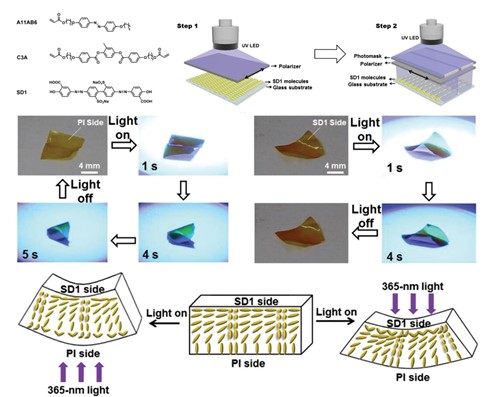Search
Title: Dual-responsive Deformation of A Crosslinked Liquid Crystal Polymer Film with Complex Molecular Alignment
Author: Quan Liu, Yuanyuan Zhan, Jia Wei, Wei Ji, Wei Hu, Yanlei Yu*
Journal: Soft Matter, 2017, 13(36), 6145-6151
Abstract:
Crosslinked liquid crystal polymers(CLCPs) containing azobenzene mesogens have been developed as stimuli-responsive materials, which can undergo photodeformation and thus convert light energy into mechanical force. The deformation behavior of CLCPs is strongly influenced by the alignment of the mesogens; however, a precise control of the alignment domain at micro-scale is still a challenge. Here we report complex molecular alignment in the CLCP film by using photoalignment technology. First, azo dye SD1 is aligned in-plane by UV light with a discrete alternating striped director profile. The SD1 molecules inadjacent strips are aligned orthogonal, and the widths of the strips are controlled in several hundred micrometers by a photomask with grating patterns.Then the liquid crystal molecules in the CLCP film are aligned by SD1 through the anchoring effect on one side (SD1 side), and aligned perpendicular by the polyimide (PI) alignment layer on the other side (PI side). With these alignments, two kinds of splayed structures are formed through the depth of the film. When irradiated by UV light, the film bends toward the SD1 side with thebending direction along the diagonal of the film, determined by the resultant direction of molecular alignment on the SD1 side. When irradiated by blue light and heat, the bending direction is along the edge of the film. This dual-responsive deformable film with complex alignment is anticipated to beused in shape-changing biomedical devices, multiple controllable switches, and microactuators.
Fulltext Link: https://pubs.rsc.org/en/content/articlelanding/2017/SM/C7SM01291H#!divAbstract

A CLCP film with complex molecular alignment is fabricated by the photoalignment technology. First, azo dye SD1 is aligned in-plane by UV light with a discrete alternating striped director profile. The molecules in adjacent strips are aligned orthogonal, and the widths of the strips are controlled in several hundred micrometers by a photomask with grating patterns. Then the mesogens are aligned by SD1 through the anchoring effect on one side of the film (SD1 side), and aligned perpendicular to the PI alignment layer on the other side of the film (PI side). With these alignments, two kinds of splayed structures are formed through the depth of the film. The bending deformation of the film is triggered by UV, blue light and heat. Different from uniaxial aligned films with splayed structure, the bending direction under UV irradiation is along the diagonal of the film, influenced by the resultant direction of molecular alignment on the SD1 side. Over-recovery occurs followed by blue light and heat-induced bending at the first time, which is explained by the release of internal stress in the film. Overall, this dual-responsive film has potential applications in shapechanging biomedical devices, multiple controllable switches, and microactuators.







